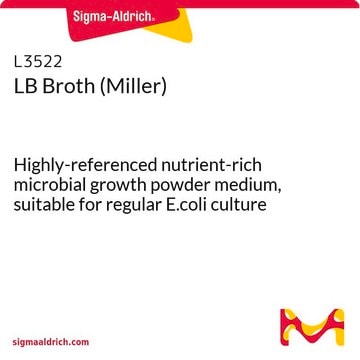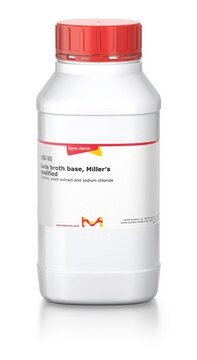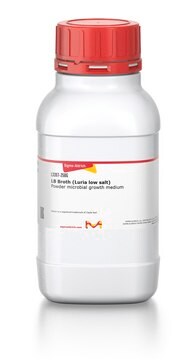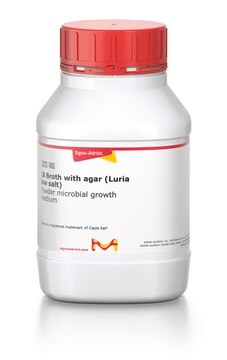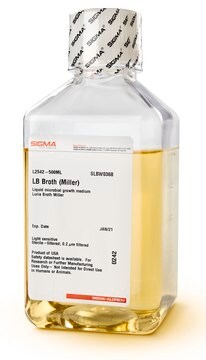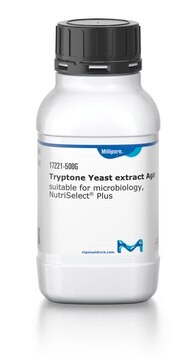L2025
Luria Agar Base, Miller
Tryptone, yeast extract, sodium chloride and agar
Synonyme(s) :
LA, modified, Luria-Bertani media, modified, Lysogeny broth, modified
Se connecterpour consulter vos tarifs contractuels et ceux de votre entreprise/organisme
About This Item
Code UNSPSC :
41106200
eCl@ss :
42040102
Nomenclature NACRES :
NA.72
Produits recommandés
Niveau de qualité
Forme
powder
Technique(s)
microbiological culture: suitable
Application(s)
agriculture
microbiology
Description générale
Luria Bertani (LB) medium is one of the complex media that is widely used to grow Escherichia coli in small-scale cultures.
Application
Luria Agar Base, Miller has been used as a growth medium during plasmid amplification. It has also been used as a culture medium for strains of Penicillium sp. laika.
Luria broth/agar (LA), Miller (L1900) is a bacteria growth mixture of sodium chloride (0.5g/L); tryptone (10g/L) yeast extract (5g/L) and agar (15g/L) used to culture members of the Enterobacteriaceae family and for coliphage plaque assays.
Composants
Contains: Tryptone, yeast extract, sodium chloride and agar.
Reconstitution
Recommended use at 30.5 g per liter.
Code de la classe de stockage
11 - Combustible Solids
Classe de danger pour l'eau (WGK)
WGK 3
Point d'éclair (°F)
Not applicable
Point d'éclair (°C)
Not applicable
Certificats d'analyse (COA)
Recherchez un Certificats d'analyse (COA) en saisissant le numéro de lot du produit. Les numéros de lot figurent sur l'étiquette du produit après les mots "Lot" ou "Batch".
Déjà en possession de ce produit ?
Retrouvez la documentation relative aux produits que vous avez récemment achetés dans la Bibliothèque de documents.
Les clients ont également consulté
Xiaoyun Qiu et al.
Applied and environmental microbiology, 70(11), 6435-6443 (2004-11-06)
We systematically investigated the physiological response as well as DNA damage repair and damage tolerance in Shewanella oneidensis MR-1 following UVC, UVB, UVA, and solar light exposure. MR-1 showed the highest UVC sensitivity among Shewanella strains examined, with D37 and
C Niu et al.
Applied and environmental microbiology, 70(12), 6951-6956 (2004-12-03)
The specific biofilm formation (SBF) assay, a technique based on crystal violet staining, was developed to locate plant essential oils and their components that affect biofilm formation. SBF analysis determined that cinnamon, cassia, and citronella oils differentially affected growth-normalized biofilm
Anthony S Danko et al.
Applied and environmental microbiology, 70(10), 6092-6097 (2004-10-07)
Pseudomonas putida strain AJ and Ochrobactrum strain TD were isolated from hazardous waste sites based on their ability to use vinyl chloride (VC) as the sole source of carbon and energy under aerobic conditions. Strains AJ and TD also use
Daria Julkowska et al.
Journal of bacteriology, 187(1), 65-76 (2004-12-17)
The natural wild-type Bacillus subtilis strain 3610 swarms rapidly on the synthetic B medium in symmetrical concentric waves of branched dendritic patterns. In a comparison of the behavior of the laboratory strain 168 (trp) on different media with that of
Yong-Guy Kim et al.
BMC microbiology, 11, 119-119 (2011-05-31)
Bacteria use diverse signaling molecules to ensure the survival of the species in environmental niches. A variety of both gram-positive and gram-negative bacteria produce large quantities of indole that functions as an intercellular signal controlling diverse aspects of bacterial physiology.
Notre équipe de scientifiques dispose d'une expérience dans tous les secteurs de la recherche, notamment en sciences de la vie, science des matériaux, synthèse chimique, chromatographie, analyse et dans de nombreux autres domaines..
Contacter notre Service technique
